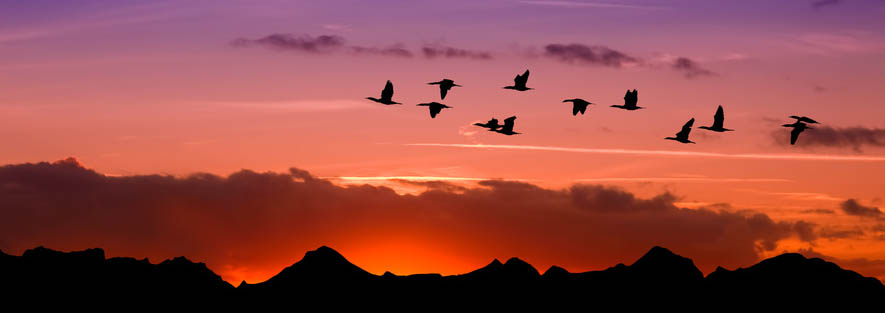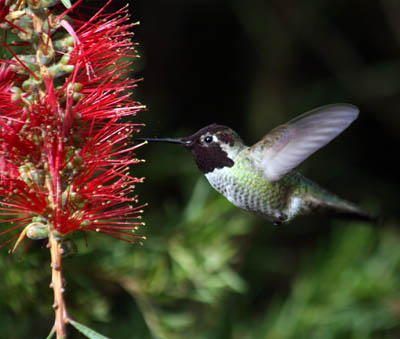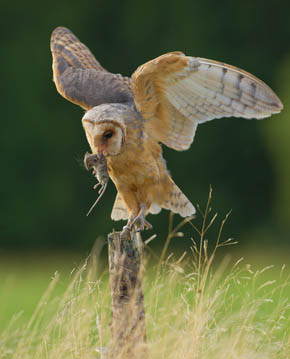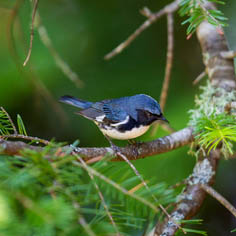Our Account of “Why Birds Matter”
The Presentation by Christopher J. Whelan Ph.D.
Sections:
A Tribute
Key Terms and Concepts
Supporting and Regulating Ecosystem Services by Birds: Nutrient Cycling, Pollination, Scavenging (Disease Reduction), and Pest Control
Dr. Whelan’s Own Research
Avian Cultural and Provisioning Ecosystem Services
Dr. Whelan’s Conclusions
RCLA Addendum: Avian Ecosystem Services in 2018 and Actions for Birds
“WHY BIRDS MATTER” — A DISCUSSION OF AVIAN ECOSYSTEM SERVICES
A Tribute
Dr. Whelan1 opened his presentation with a tribute to Rachel Carson’s legacy in appreciation for Silent Spring.
Key Terms and Concepts
To introduce his subject Dr. Whelan defined key terms and concepts pertinent to avian ecosystem services:
-
an ecosystem is a unit composed of organisms (animals, plants, fungi, bacteria) together with their physical environment).
- ecological function is the role of a species in its ecosystem (for example: as a producer, or a consumer).
- ecosystem services refers to any component of nature that benefits humans. Avian Ecosystem Services (from birds) is an area of recent scientific interest and study.
- Birds are important ecosystem service providers because: They are widespread and diverse. They perform a number of ecological functions. They are highly mobile and often have been abundant.
- Ecosystem services by birds are sorted into four categories:
Supporting Services (nutrient cycling, contributions to primary production),
Regulating Services (controlling pests, reducing disease),
Provisioning Services (providing food, and fiber) and
Cultural Services (linked to aesthetic, recreational, and spiritual experiences).
Supporting and Regulating Ecosystem Services by Birds
Whelan considered Avian Supporting and Regulating Ecosystem Services together due to overlapping functions. Under this combined group he focused on four types of ecosystem services by birds: Nutrient Cycling, Pollination, Scavenging (disease reduction), and Control of (pest insects and pest rodents).
Nutrient Cycling by Birds: Generations of sea birds nesting in areas along the coast of Central and South America have deposited guano (waste material which is rich in phosphate, nitrogen and other nutrients as a result of the birds’ fish-based diets). These sea birds carried out nutrient cycling by bringing the ocean-based material to land, where it could be collected and marketed (in North America and elsewhere). In the late 1800s, this material served as a vital fertilizer component in supporting agriculture, and as a raw material for the manufacture of certain explosives — prior to the early 1900s when the Haber Bosch process was developed (directly synthesizing ammonia from nitrogen and hydrogen). Wars were fought and territory in South America lost and gained in the conflicts to establish access to guano by commercial interests.
Pollination by Birds: Although the valuable Supporting Service of pollination is mostly performed by insects, birds also provide this service for some plants. The monetary value of pollination in the US is $40 billion, and Worldwide is $200 billion.
Scavenging (Disease Reduction by Birds): For generations Vultures in India feeding on carcasses of cattle have helped limit populations of wild dogs by removing a potential food source. When in the 1990s and early 2000s numbers of Indian vultures declined (and their scavenging services diminished), roaming wild dog populations grew more numerous due to feeding on the increasingly available cattle carcasses. With the greater numbers of scavenging dogs there were more rabies cases causing many more deaths in both the canine and in the human populations. For humans, 48,000 rabies deaths (between 1993 and 2006) were linked to the decline in scavenging services by vultures. Researchers eventually determined that vulture numbers were reduced due to the birds being poisoned by a veterinary drug widely used to treat cattle. Vultures were exposed to the drug when feeding on carcasses of treated cattle. Once the loss of Indian vultures was linked to the use of the veterinary drug (diclofenac), the drug was banned by the government.
Pest Control by Birds (Pest Insects, Pest Rodents): In Dr. Whelan’s experience insect-eating birds can provide services that are equal to and in some ways superior to the actions of chemical insecticides (such as DDT and others) for control of pest insects. Why? Birds as a group are better at controlling insect pests because each bird species has its own unique ecological niche, and each has its own foraging strategy. Birds naturally exist in different levels of the ecosystem: some are ground feeders (sparrows) some are treetop feeders (warblers), some catch insects on the wing (swallows, swifts, flycatchers), others feed at midpoint in the tree canopy. Birds’ diverse feeding styles make it hard for the plant eating insects to develop a “one size fits all” defense against bird predation in the same way that pest insects become resistant to chemical insecticides (such as DDT and others).
Birds have successfully controlled insect pests in apple orchards, and in fields of commercially-grown broccoli. In the coffee plantations of Central America Black-throated blue warblers consume caterpillars and other insects that damage coffee plants.
As Dr. Whelan stated – Birds are examples of “EFFECTIVE and RESISTANCE-PROOF biological insecticides.”
Pest Rodents: Birds can function as biological rodenticides. Barn owls have been used as biological rodenticides in agricultural areas worldwide including: in palm oil plantations, in a variety of field crops (wheat, sweet corn, alfalfa, corn, and oats), as well as in date plantations. They are effective agents for rodent control.
Dr. Whelan’s Own Research
A study carried out in a Missouri white oak forest by Dr. Whelan and Dr. Marquis considered the question – “Can birds benefit plants by consuming plant-eating insects?” In planning the work these researchers adopted a plant-centered view-point. Young (sapling) white oak trees were sorted into three experimental groups. In the first group, the trees were surrounded with netting making them accessible to insects but not to birds. In the second (control) group uncovered oak trees were exposed to insects and birds. In the third group the oak saplings were treated with an insecticide and they remained uncovered (exposed to birds and insects).
In each of the three groups the researchers measured the total quantity of leaves per tree at the end of the experiment which they termed “leaf biomass.”
Results of the Whelan/Marquis study showed that the caged sapling trees from which the birds but not the insects were excluded had a significantly reduced leaf biomass when compared to either the untreated controls or to the insecticide-treated trees. These results showed that keeping the birds from reaching the trees by covering them with netting allowed insects to feed on and damage more leaves than in either of the other groups where birds could access the trees and feed on the leaf-eating insects. It also showed that the beneficial effect of the birds feeding on and removing damaging insects by itself was comparable to the spraying of a chemical insecticide in terms of reducing the number of insects damaging the leaves.
The study results, expressed from the trees’ perspective showed that: “The enemy of my enemy is my friend.” This is an example of the top down effect, described in ecology as a “trophic cascade” 2.
The Missouri oak forest study, the examples of birds removing pests from commercial crops (in coffee plantations, in apple orchards, and in fields of broccoli) indicate, in Dr. Whelan’s words, “Birds can control insect pests in agricultural ecosystems, precluding the use of harmful pesticides!”
Avian Cultural and Provisioning Ecosystem Services
Birds Cultural Ecosystem Services
Dr. Whelan noted that birds have inspired artists, writers and musicians throughout history. They continue to be responsible for tourism, falconry and birdwatching (birding), a major hobby. In the U.S. alone there were 45 million birdwatchers, supporting over 860,000 jobs in 2001. The numbers have increased significantly per 2018.
Birds Provisioning Ecosystem Services
Eider Ducks are a source of down for insulation and bedding, a service that has been accomplished sustainably. Ducks and geese are hunted for food. Funds collected from hunters support maintenance of natural areas such as parks and refuges.
Dr. Whelan’s Conclusions
Dr. Whelan closed by noting that the economic perspective associated with the ecosystem services, “deserves to be a tool in our conservation toolbox – but it can’t be the only tool.”
He emphasized that birds and nature have intrinsic value.
He mentioned Aldo Leopold’s Land Ethic as a natural progression in human moral and ethical evolution.
Finally, Dr. Whelan reminded us that our ultimate goal should be better decision-making — that improves human lives while conserving the natural world that sustains us. This approach is important from the perspective of envisioning the earth as a life-support system — a concept consistent with the philosophy of Rachel Carson as expressed in Silent Spring.
RCLA Addendum: Avian Ecosystem Services in 2018
Regulatory
Today, with chemical insecticides losing favor, due to toxic effects in people, bees, and other organisms as well as due to the development of resistance to these chemicals in the target pests, it’s vital to seriously consider Dr. Whelan’s statements: “Birds can control insect pests in agricultural ecosystems, precluding the use of harmful pesticides! [and] It’s “usually more cost effective to protect the ecosystem service than to recreate it.” (2018 Rachel Carson Open House.)
Research by Dr. Whelan and others indicates that landscapes could be designed to welcome wild birds as substitutes for chemical pest controls. Barn owl nest boxes in orchards have resulted in avian rodent control replacing chemical rodenticides. Organic coffee growers in Central America have found that Black-throated blue warblers effectively remove leaf-eating caterpillars from coffee plants reducing the need for chemical insecticides.
Birds providing pest control save farmers the cost of chemicals and contribute to functioning ecosystems that could help to keep farmers, their farm lands, their streams and rivers as well as the surrounding communities healthier.
Cultural
Avian cultural services help people connect to nature, with experiences of beauty, discovery and delight. The simple pleasures of observing birds or listening to their songs can lift the spirits of many (including artists, photographers, musicians and birding hobbyists).
Preserving Avian Ecosystem Services by Protecting Birds
Chemical company people in Rachel Carson’s day scoffed at those objecting to the poisoning of birds by DDT and other pesticides just as today the fossil fuel energy companies, their agents and certain legislators seek the removal of all legal constraints against the killing of birds by industrial actions be they oil spills, chemical spills, or even unprotected waste oil pits (known death traps for migratory birds).
The usefulness to farmers, foresters 3 and others of avian ecosystem services raises the question:
“Who has the right to reduce or eliminate birds and their services?”
This question is particularly relevant when under the Trump administration government agencies have removed previous protections for birds afforded by the Migratory Bird Treaty Act (MBTA) (For more about Trump Administration & the MBTA see RCLA Action Alert: Migratory Birds At Risk From A Preventable Death Threat). Further, recent steps to remove ecosystem protections for birds and others under the Endangered Species Act raise the question: “Who pays the price for species’ extinctions?” 4
There are various ways that birds’ positive monetary impact on human society can be described. 5 The economic valuation of avian ecosystem services needs greater public prominence in order to convey the many reasons for keeping birds safe from: habitat loss, diminished food sources, pesticide use, industrial accidents, and predation by free-roaming cats.
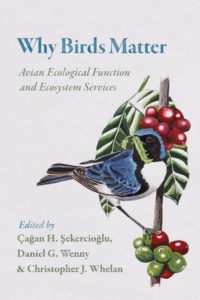 Those who wish to continue discovering more on this important topic can begin by consulting the excellent 2016 reference of which Dr. Whelan is a co-editor, Why Birds Matter. 6
Those who wish to continue discovering more on this important topic can begin by consulting the excellent 2016 reference of which Dr. Whelan is a co-editor, Why Birds Matter. 6
We thank Dr. Whelan for his riveting and informative science-based presentation on avian ecosystem services. It provided our audience with the taste of an exciting field of study on birds in our lives in this the “Year of the Bird.” We hope it will empower many who care about the natural world to take steps to help protect birds and their food sources on private property, and/or local public spaces as well as to share information with family and friends.
ACTIONS FOR BIRDS
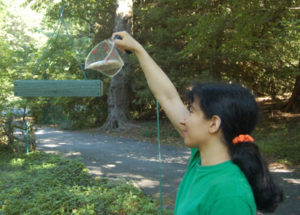 Below is a list of supportive actions to enhance the contributions of birds and respond to their need for our help:
Below is a list of supportive actions to enhance the contributions of birds and respond to their need for our help:
- Be mindful that bird populations are in decline and need help to recover;
- Provide nest boxes for birds on your property and in public spaces;
- Grow plants that provide seeds, and fruit for birds (such as Purple Cone Flowers, Blueberries, Winterberries, Beautyberries, Mulberries);
- Provide clean water and seed for birds on your property;
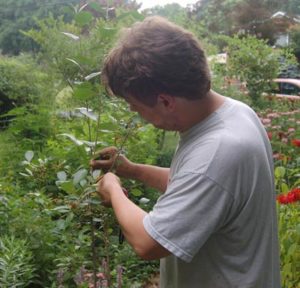 Provide safe resting/nesting places for songbirds (hedges, rose bushes or other plants with thorns to protect nestlings from predators);
Provide safe resting/nesting places for songbirds (hedges, rose bushes or other plants with thorns to protect nestlings from predators);- Purchase only recycled paper products;
- Don’t allow your cats to roam free where birds are in residence;
- Don’t use chemical pesticides where birds are present;
- Take time to learn more about avian ecosystem services so that you can make a strong case for the value of birds threatened by loss of habitat, reduction of legal protections, or other negative impacts.
- Support RCLA with a donation.
When we lose birds we lose the valuable ecosystem services that they provide.
By Diana Post & Munro Meyersburg, August 24, 2018
Footnotes
1 Whelan Biosketch: Christopher J. Whelan, Ph.D. is an Evolutionary Avian Ecologist with broad interests in the functional roles that birds play within ecosystems. Whelan received a BS in Wildlife Ecology at the University of Wisconsin at Madison, and a Ph.D. from Dartmouth College. After a postdoc at the University of Illinois (Urbana-Champaign), Whelan moved to the Chicago region, where he has been associated with the U. of IL at Chicago since 1991. He is a Research Associate with the Field Museum of Chicago.
2 (Definition of “Trophic Cascade”) A trophic (feeding) cascade is an indirect interaction in which a top avian predator benefits the resource (a plant/tree) owing to its consumption of an intermediate predator (insect pest).
3 Foresters and Birds: It is estimated that worldwide, insect-eating birds consume 400-500 million tons of insects each year. “Much of [the birds’] insect consumption happens in forests, yet forestry companies generally don’t manage habitat with insect-eating birds in mind, much less protect migratory insect-eaters elsewhere on their journeys.” (Keim, B., “The incredible value of insect-eating birds,” http://www.anthropocenemagazine.org/2018/08/)
4 When a chemical pesticide is registered under The Federal Insecticide, Fungicide and Rodenticide Act (FIFRA) by the USEPA there is a requirement for consultation with the Interior Dept about the protection of listed (endangered and threatened) species under the Endangered Species Act (ESA). The reason for the consultation is that “The EPA’s ecological risk assessments often show that the legal applications of certain pesticides will almost certainly kill non-target species that happen to be nesting, feeding, flying or swimming in and around treated farm fields…in the real world of pesticide regulation, birds, fish and bees are expendable.” (Dr. Chuck Benbrook, Pesticides News 82, Dec 2008) Bird habitat and food sources are not required to be protected from pesticide poisoning under FIFRA, but they are required to be protected under the ESA. When under ESA use of a toxic chemical pesticide is prohibited in order to protect a listed species, other wildlife sharing the habitat also benefit. The ESA’s habitat requirements (in addition to protection from pesticides’ hazards) have safe-guarded ecosystems from commercial development in: forests, areas along coasts and parts of the Everglades.
5 Positive economic impacts of avian ecosystem services:
- The additional human deaths from rabies due to the loss of Indian vulture scavenging services amounted to an economic cost of $34 billion during the period between 1993 and 2006. (Sekercioglu, C., et al, Why Birds Matter, 2016, U of Chicago Press)
- The monetary value of pollination in the US is $40 billion, and Worldwide is $200 billion. Birds contribute to this service. (Dr. Whelan, 2018 Open House)
- Over 50 million American birdwatchers, having a huge economic impact, are estimated to spend $26 billion yearly on equipment. (Robbins, J., The Wonder of Birds, 2017, Spiegel & Grau)
- There is the uncalculated monetary value to a vineyard of replacing the regular use of chemical insecticides with bluebird nest boxes in order to invite these worker birds to take up residence and control the blue-green sharpshooter a pest insect found in California’s Napa Valley. (Robbins, J., The Wonder of Birds, 2017, Spiegel & Grau)
6 Why Birds Matter, Edited by Çağan H. Şekercioğlu, Daniel G. Wenny & Christopher J. Whelan, University of Chicago Press, August 2016, has been described as “a one stop summary of what we know about the contributions of birds to ecosystem services.” (Chris Elphick) and as offering “a new understanding and appreciation of just what a contribution birds make to our world and our lives.” (Jeffrey A. Gordon)

